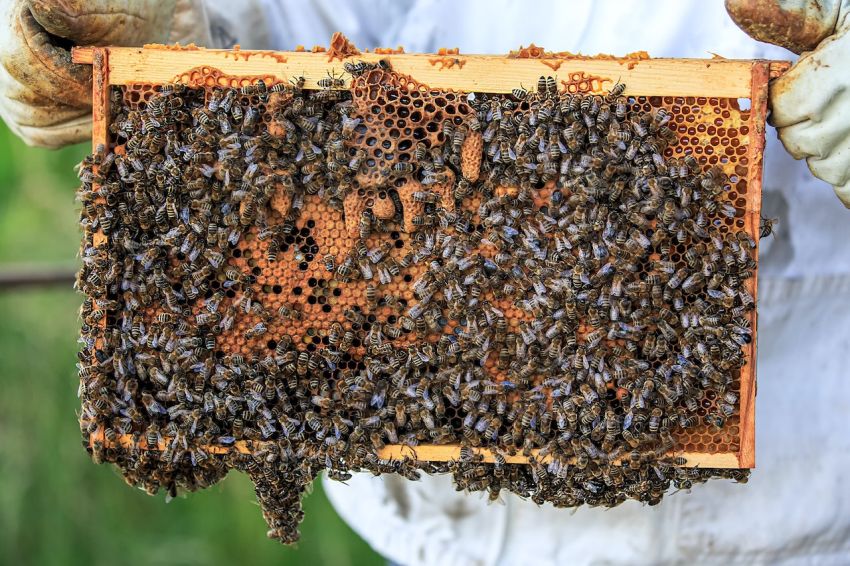The choice of wax can play an important role in decision-making when you’re out buying candles, scented or otherwise. While there are quite a few options available, the traditional wax choices often come down to beeswax vs paraffin.
Both beeswax and paraffin have their individual characteristics, benefits, and negatives. If one fits in one situation the other may not. And you can’t always get an absolute cut and dry answer on which one works better.
To decide which is better out of the two comes down to your personal preference. It could be the scent, price, source, or durability.
Let’s touch upon a few popular criteria that one could think of when choosing between a beeswax and a paraffin candle.
A Comparative Analysis Of Beeswax vs Paraffin: Factors To Consider
1. Beeswax Or Paraffin: Which Is A Natural Product?
Beeswax is naturally produced by bees. Bees convert honey into beeswax through their wax glands. It’s a blend of nectar and pollen that ascribes a natural tag to them.

Now let’s talk of paraffin. Paraffin is obtained as a byproduct during the process of filtering crude oil to obtain petroleum. Crude oil is a naturally occurring liquid found in the deep crust of the earth. However, its by-product, paraffin, undergoes repetitive refining steps until it is separated from the oil.
Besides, a lot of chemicals and solvents are used in the crystallization of paraffin wax.
Paraffin wax is further bleached with chemicals to impart a white look to it and render it odorless. Thus, it turns out to be more of a chemical product.
Out of the two, beeswax comes much closer to being a natural product.
2. Beeswax And Paraffin Wax Affect The Environment
Beekeeping today has turned into a commerce-centric enterprise. With the large-scale commercialization of beeswax and other bee products, some beekeepers often do rampant bee harvesting.
Sometimes, the beekeepers slice off the hives before there is enough honey and beeswax to extract. This renders bees homeless or sometimes bees are trapped and killed in the process.
When done ethically, beekeepers use beeswax that they extract while pouring honey out of the hives. It’s the surplus wax. These beekeepers value the well-being of bees. They appreciate the critical role they play in our ecosystem.
Paraffin wax is simply a by-product, which is obtained as the crude oil undergoes refining. However, its source, petroleum refineries are counted amongst the major environmental pollutants in the United States.
The process of refining crude oil takes a toll on the health of the environment. It leads to a large quantity of smoke emission in the air. Besides, a lot of toxic materials and gases like carbon monoxide, methane, and benzene are released in the air.

We all know fossil fuels are a nonrenewable resource and it’s best to reduce our dependence on them. Paraffin wax is a very small percentage of fossil fuel resources. But its association with the oil and petroleum industry generates a negative impact on the environment.
3. Beeswax Is Claimed To Hold Health Benefits
There are several benefits ascribed to beeswax candles. Some of these are true, while other claims are a stretch, to say the least.
Beeswax candles fetch a higher market price as these are believed to purify the indoor air. It is claimed that these emit negative ions that attract dust, odor, and mold. Thus making the air healthier to breathe in. However, there isn’t scientific evidence to back up these claims.
Still, it is a candle of choice for those who are sensitive to chemicals, have respiratory issues, and are allergic to strong scents. A pure beeswax candle has a mild honey-like ingrained scent and is gentle to use.
Paraffin candles, however, are not known to hold any health element. There are claims that these release harmful chemicals and most of smoke emission. Especially, when burnt in a cluster over any occasion. Its advisable to keep a provision for cross-ventilation.

4. Paraffin Wax Works Great With Scents And Colors
A distinguishing feature of paraffin wax is its availability in a wide array of scents and colors.
For most candle manufacturers, paraffin wax is their material of choice. Paraffin is capable of holding a wide variety of scents for longer and gives a more robust scent throw than other waxes. And on first impression, a scented candle is meant to emit a good fragrance.
You can play with as many colors when it comes to adding them to paraffin candles. Paraffin candles are considered best for highly saturated colors. These can range from fluorescents to darker shades.

Beeswax candles too can be colored but you find them more in natural shades of yellow, off-white, and white.
Beeswax candles are naturally scented candles. These have a unique honey aroma. For people who are sensitive to scents and like mild aromas, beeswax can be a good choice.
5. Both Paraffin And Beeswax Can Be Molded Into Many Shapes
When it’s about giving different shapes to candles and experimenting with style, paraffin wax and beeswax perform well. Both are suitable to mold into large pillar candles, tapered candles, votive candles, and small tealight candles. These are easily poured into tin and glass containers.

However, beeswax makes a better wax base for pillar and taper candles as it doesn’t drip.
6. Beeswax Candles Last Longer Than Paraffin Candles
Having an idea of how long a candle will last is important. When you spend good bucks on these you want to get the most out of it and that it lasts longer.
Usually, it is seen that beeswax candles burn longer than other types of wax candles. This is because beeswax has a high melting point and this lets you get a long-lasting burning candle.
To some claims, beeswax candles can burn up to four times longer than similarly sized paraffin wax candles. Beeswax candles are also dripless, so there’s no worry about the wax drippings or mess.

To overcome this shortcoming in paraffin wax, some candle manufacturers use additives to make them last longer. But still, it doesn’t work wonders. Besides, paraffin candles drip, which takes much of their life away too quickly.
7. Beeswax Candle Emit A Brighter Light
The first attribute of a burning candle is its flame. With beeswax candles, you get the brightest of candlelight and warmth. A higher melting point makes it emit a stronger bright flame.
Paraffin wax has a low melting point, which makes it quick to burn down. Compared with beeswax candles it gives a little whitish flame which is very feeble.
So if you want to light a candle in a dark room and want its glow to spread far, try using a beeswax candle.
8. Beeswax Is More Expensive Than Paraffin Wax
For centuries beeswax candles have earned the reputation of being a luxurious item. Beeswax often commands a higher price tag than other options. It’s usually more expensive than paraffin.
Beeswax candles are costly beauties because it’s an all-natural product. Besides, a lot of raw material goes into making a beeswax candle. It takes about eight pounds of honey to get a pound of beeswax.
One of the key reasons for the popularity of beeswax is its cost. When compared to paraffin candles, beeswax candles can cost up to ten times more. Often, for candle-makers as well as consumers, paraffin wax makes for a better economic choice.
Moreover, paraffin candles are an ideal choice when it comes down to lighting many candles at a time. This can be for any festive occasion like Christmas or massive decorations.

Choosing Between Beeswax And Paraffin Is About Making A Personal Choice
Candle wax is the fuel for your candle and it makes a difference in the performance of your candle. Once you are aware of its relevance you know better what to expect from a particular candle wax. Choosing between beeswax vs paraffin is all about your personal preference.
If you are fond of a variety of aromas and colors for your candle, then paraffin candles can be the right choice. But if you like unscented or lightly scented candles, choose beeswax candles.
Beeswax candles don’t drip and last significantly longer than paraffin candles. Although beeswax candles are expensive and command a higher price than paraffin candles.

